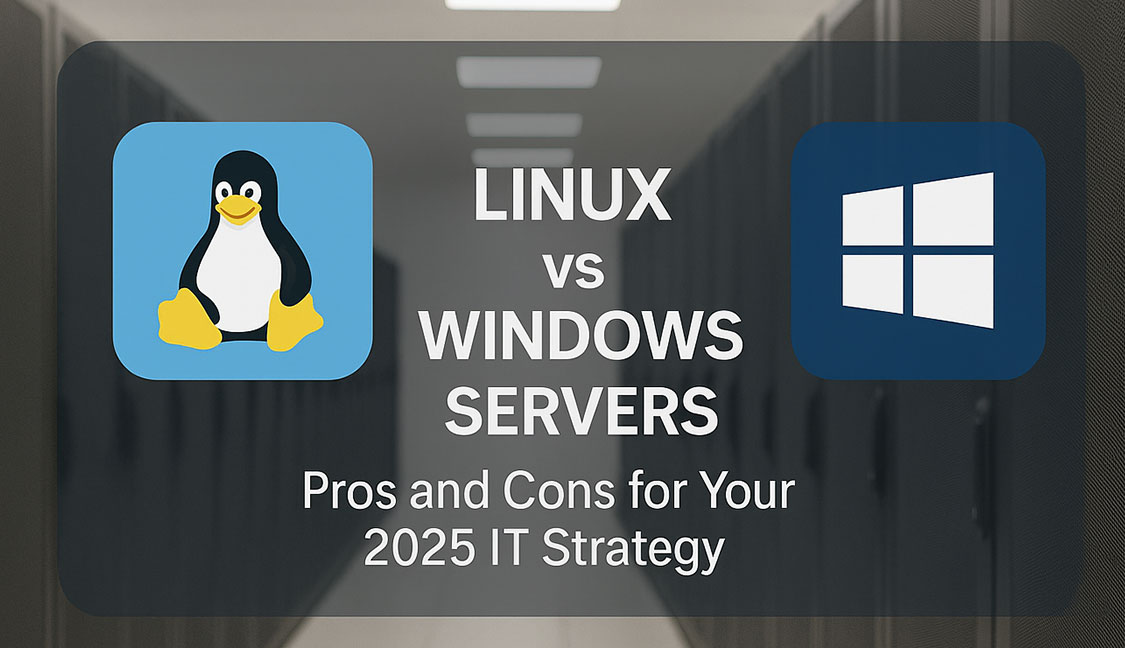 Navigating the 2025 Server Landscape
Navigating the 2025 Server Landscape
Navigating the 2025 Server Landscape
In 2025, businesses are navigating an increasingly complex IT environment driven by cloud-native computing, AI workloads, and hybrid cloud strategies. Amidst this technological evolution, one debate continues to shape IT decision-making: Linux or Windows Servers-Which is the right choice for your business?
This decision goes beyond personal preference. It impacts your infrastructure’s scalability, security, cost-efficiency, and long-term sustainability. IT leaders must evaluate how each platform aligns with business needs, operational demands, and growth strategies. Making the right server platform choice is a strategic move toward ensuring your infrastructure’s long-term scalability and reliability.
Key Differences Between Linux and Windows Servers
At the core of the Linux vs Windows server comparison are vastly different philosophies. Renowned for its adaptability and openness, Linux is an open-source operating system shaped by collaborative community development. Its modular design enables tailored configurations, making it ideal for customization and specialized workloads.
In contrast, Windows Server is a proprietary platform by Microsoft, offering deep integration with enterprise solutions such as Active Directory, IIS, and the broader Microsoft ecosystem. Its graphical user interface (GUI) appeals to IT administrators accustomed to user-friendly management consoles.
- Linux servers typically use tools like cPanel, Webmin, or Plesk for web hosting and apt, yum, or dnf for package management.
- Windows Servers rely on PowerShell scripting and GUI-based configuration, streamlining operations in Windows-centric environments.
If your team prioritizes granular control and command-line flexibility, Linux stands out. But for enterprises managing large-scale Microsoft deployments, Windows Server offers seamless compatibility.
Licensing and Cost: Which Platform Saves More?
When evaluating server costs in 2025, consider the Total Cost of Ownership (TCO), not just initial licensing fees.
- Linux servers, such as Ubuntu, CentOS Stream, or Debian, are free to install and deploy. Organizations can expand their Linux environments without facing additional licensing costs.
- Windows Server, however, requires paid licenses, including Client Access Licenses (CALs), virtual machine (VM) licensing, and SQL Server fees. As your infrastructure scales, these costs add up.
For startups and SMBs aiming to control IT budgets, Linux presents an attractive, low-cost solution. Larger enterprises, on the other hand, may find the cost of Windows justified by its extensive support, compatibility with legacy systems, and standardized upgrade paths.
Hidden costs such as downtime from misconfigurations or a lack of in-house Linux expertise should also be factored into your decision.
Security in 2025: Which Server Stands Stronger?
Cybersecurity threats are evolving rapidly, making security a critical deciding factor.
- A worldwide community of security experts actively contributes to the protection and resilience of Linux servers. Security patches are issued quickly, and its permission system minimizes risk from unauthorized access.
- Windows Server has improved significantly, with tools like Microsoft Defender for Endpoint, BitLocker encryption, and centralized patch management strengthening its defenses. However, its popularity still makes it a bigger target for cyberattacks.
In a Zero Trust architecture, Linux’s modularity supports containerization and microservices security, while Windows Server excels in centralized security policy enforcement.
Ultimately, both systems are secure when configured correctly. Linux offers deeper customization, while Windows simplifies policy management across large organizations.
Performance: Uptime, Resource Optimization, and Scalability
Performance is where Linux servers typically outshine. Thanks to their lightweight design, Linux servers use fewer resources, making them a preferred choice in web hosting, data centers, and high-performance computing.
Linux also powers most containerized environments, excelling in cloud-native deployments using Docker and Kubernetes. Its optimized process scheduling and memory management give it a performance edge.
Windows Server, however, is essential for running legacy enterprise applications, .NET frameworks, and SQL Server databases. Though it has a higher resource footprint, it compensates with enterprise-grade reliability and intuitive diagnostics.
Hybrid infrastructures benefit from both platforms: Linux provides scalable, budget-friendly solutions, whereas Windows Server powers critical enterprise applications.
Ecosystem & Support: Who’s Got Your Back?
Support and ecosystem integrations often sway server decisions.
- With Linux, you can leverage robust community forums, open-source documentation, and enterprise-grade support from providers like Red Hat, Canonical (Ubuntu Pro), and SUSE.
- Windows Server users benefit from Microsoft’s structured support system, featuring certified professionals, extensive documentation, and streamlined troubleshooting.
While Windows tends to lock users into Microsoft’s ecosystem, Linux offers greater freedom. That said, organizations without in-house Linux expertise may face a steeper learning curve when adopting the platform.
Ideal Use Cases for Linux and Windows Servers
Linux Servers Are Best For:
-
- Web hosting platforms (Apache, Nginx, LAMP/LEMP stacks)
- DevOps pipelines and CI/CD automation
- Containerized, microservice architectures
- Startups and SMBs seeking scalability without high costs
Windows Servers Excel In:
- Enterprise networks using Active Directory and Group Policy
- Applications built on .NET and Microsoft SQL Server
- Remote desktop services and terminal services
- Industries with strict compliance and centralized management needs
Increasingly, businesses adopt hybrid server environments-Linux for scalable apps and Windows for legacy enterprise operations.
actsupport delivers seamless Linux and Windows Server support.
Power your business with expert IT management.
Conclusion: Which Server Should You Choose in 2025?
The Linux vs Windows server debate in 2025 isn’t about declaring a universal winner. Instead, it’s about aligning your infrastructure with your business priorities.
- Choose Linux if you value open-source flexibility, lower costs, and community-driven innovation.
- Opt for Windows Server when your business relies heavily on the Microsoft ecosystem and demands robust, enterprise-level support.
For many organizations, the smart choice is a hybrid infrastructure, leveraging the strengths of both platforms.
Make your decision based on your workload needs, team expertise, and long-term vision. A strategic approach today ensures that your servers deliver performance, security, and scalability tomorrow.Stay updated! Follow us on social media! Facebook, Twitter, LinkedIn
Check out our newest blog entry (Server Hardening for Security & Uptime)




